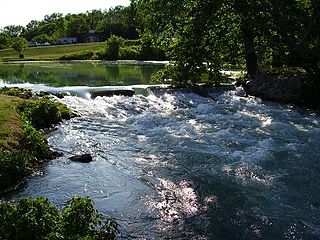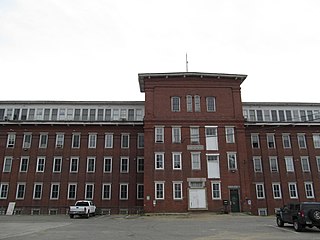
Mammoth Spring State Park is a 62.5-acre (25.3 ha) Arkansas state park in Fulton County, Arkansas in the United States. The park is located surrounding National Natural Landmark of the same name to provide recreation and interpretation for visitors. The park offers fishing, boating and hiking in addition to an Arkansas Welcome Center and restored 1886 St. Louis–San Francisco Railway (Frisco) depot operating as a railroad museum. The site became a state park in 1957, but the park continued to add area until 1975.

The National Register of Historic Places in the United States is a register including buildings, sites, structures, districts, and objects. The Register automatically includes all National Historic Landmarks as well as all historic areas administered by the U.S. National Park Service. Since its introduction in 1966, more than 90,000 separate listings have been added to the register.

The Slater Mill is a historic textile mill complex on the banks of the Blackstone River in Pawtucket, Rhode Island, modeled after cotton spinning mills first established in England. It is the first water-powered cotton spinning mill in North America to utilize the Arkwright system of cotton spinning as developed by Richard Arkwright.

Lake Hamilton and Lake Catherine are a pair of man-made lakes located in Hot Springs, Arkansas, serving as a tourist attraction for the area. Both Lakes were developed by Arkansas Power & Light.

The Camden Expedition Sites is a national historic landmark consisting of nine nationally significant historic places in southwest Arkansas where events of the Union army's disastrous Camden Expedition of 1864 occurred during the American Civil War. The Union was attempting to take over Shreveport, Louisiana. Each of the sites are individually listed on the National Register of Historic Places. It was designated a national historic landmark on April 19, 1994.

Jenkins' Ferry Battleground State Park is the site of the American Civil War battle of Jenkins' Ferry, also known as the Engagement at Jenkins' Ferry, fought on Saturday, April 30, 1864, in present-day Grant County, Arkansas. The park was listed in the U.S. National Register of Historic Places on January 21, 1970, and, with seven other sites, is part of the Camden Expedition Sites National Historic Landmark, designated a National Historic Landmark District on April 19, 1994.

Marks' Mills Battleground State Park is an Arkansas State Park located at the junction of Arkansas Highway 8 and Arkansas Highway 97, north of New Edinburg, Arkansas. It preserves a portion of the battlefield of the Battle of Marks' Mills fought on April 25, 1864, in the Trans-Mississippi Theater of American Civil War. The battle was part of the Camden Expedition. The park is one of nine historic sites that make up the Camden Expedition Sites, a National Historic Landmark District. The battle was most know for the slaughter of black Union soldiers that were murdered as they try to surrender.

The Talcottville Historic District is a historic district in the town of Vernon, Connecticut. Centered on Elm Hill Road and Main Street, it encompasses a 19th-century mill village, including archaeological remnants of very early cotton-spinning facilities, and old stone dam, and a major wood-frame mill constructed by the Talcott brothers. Also included in the village are a significant number of mill worker housing units, many dating to the middle decades of the 19th century, and an 1891 lenticular pony truss bridge, built by the Berlin Iron Bridge Company. The district was listed on the National Register of Historic Places in 1989.
Osage Mills is an unincorporated community in Benton County, Arkansas, United States. The millsite and associated dam is located on Little Osage Creek about eight miles southwest of Rogers. It is the location of the following places listed on the National Register of Historic Places on January 28, 1988:

This is a list of the National Register of Historic Places listings in Independence County, Arkansas.

The War Eagle Bridge is a historic bridge in War Eagle, Arkansas, United States, that is listed on the National Register of Historic Places.

The Baxter County Courthouse is a courthouse in Mountain Home, Arkansas, United States, the county seat of Baxter County, built in 1941. It was listed on the National Register of Historic Places in 1995. The building replaced another courthouse on the same site which was deemed unsafe in 1939.

The Dundee Canal was an industrial canal in Clifton and Passaic in Passaic County, New Jersey. It was built between 1858 and 1861 and ran parallel to the Passaic River. It supplied hydropower and water for manufacturing. There was interest by some members of the business community to modify the canal to support navigational uses, but the canal was never used for that purpose.

The Bennington Village Historic District of Bennington, New Hampshire encompasses the 19th-century center of the village. Growth of the village followed a typical pattern for rural New Hampshire towns, based in this case around the growth in the early 19th century of the paper industry, which continues to be a significant economic force in the community. The district is centered on the junctions of Main, Center, and School Streets with Bible Hill Road and Francestown Road. The district was listed on the National Register of Historic Places in 2010.

The Salmon Falls Mill Historic District encompasses a historic mill complex on Front Street in Rollinsford, New Hampshire. The complex includes four major structures and seven smaller ones, on about 14 acres (5.7 ha) of land along the Salmon Falls River. They were built between about 1840 and the mid-1860s, and have an unusual architectural unity, for additions made to the buildings were done with attention to matching design elements from the existing structures. The Number 2 Mill, built in 1848, was an early location where a turbine was used instead of a waterwheel to provide power to the mill machinery. The district was listed on the National Register of Historic Places in 1980.
The C.A. Stuck and Sons Lumber Mill is a historic industrial complex at 215 Union Street in Jonesboro, Arkansas. It consists of four buildings: an office building, a lumber mill, and two storage sheds. All four buildings are brick structures built c. 1890, although the office building was enlarged and given a new facade in 1905. The Stuck mill, which was established in 1889, is one of the oldest properties associated with the early efforts to deforest Craighead County. C.A. Stuck was an Illinois-based furniture builder who moved to Jonesboro to facilitate the production of lumber for his products.

The Osage Mills Dam is a historic dam in rural Benton County, Arkansas. It impounds Little Osage Creek, just upstream of Mill Dam Road, between Rogers and the Northwest Arkansas Regional Airport. The dam was built c. 1890 out of coursed stone with a rusticated face. It was built to provide power to a grist mill that served the area, of which only a small portion of the millrace remains visible. The dam is the only known structure of its type in the county.

Headquarters is an unincorporated community located within the Amwell Valley of Delaware Township in Hunterdon County, New Jersey. The settlement is centered around the intersection of Zentek Road and County Route 604. It is about 3 miles (4.8 km) from Ringoes to the east and 1 mile (1.6 km) from Sergeantsville to the west. The Headquarters Historic District was listed on the state and national registers of historic places in 2011 and had its boundary increased in 2016.

The Spring Mill is an historic industrial property on Arkansas Highway 69, 6 miles (9.7 km) northwest of Batesville, Arkansas. It is a wood-frame structure with a gambrel roof and clapboard siding, set in a stone foundation at the eastern end of its mill pond, with a concrete-reinforced stone dam extending further to the north. The dam was built in 1867, by Colonel J. A. Schnabel, replacing an earlier log dam, and the building was built about 1869. It is the only known operable grist mill from the period in the state. A.N. Simmons had the Colonel build the Mill. Mr. Jordan James bought the Mill from Simmons in 1873. It then passed through the McCrory Family, Roland Headstream Family, and Coop Family. The John Anderson Lytle, Sr. family purchased the Mill in 1917, then passed it to his son John A. Jr, and daughters Edna Grace Lytle Watts, and Helen Gertrude Lytle Bell, in 1934. John & his wife, Ora Ophelia Stewart Lytle made it an operable community landmark for decades, along with their 7 living children. Cold spring water was hauled to neighbors, as well as folks would bring corn to grind into flour and meal. The store also sold various items as well as fish food to feed the plentiful, large rainbow trout in the Mill Pond. The Mill remained in the Lytle family until 2018 when it was sold to the current owners.

The Thresher Mill is a historic industrial facility on West Barnet Road in Barnet, Vermont. First developed in 1836, it was the last water-powered mill to operate on the Stevens River, lasting into the late 20th century. The property, which includes an original mill dam and a surviving 1872 mill building, as well as archaeological sites of other industrial buildings, was listed on the National Register of Historic Places in 1996. It is now styled Ben's Mill, and is a local museum.


















